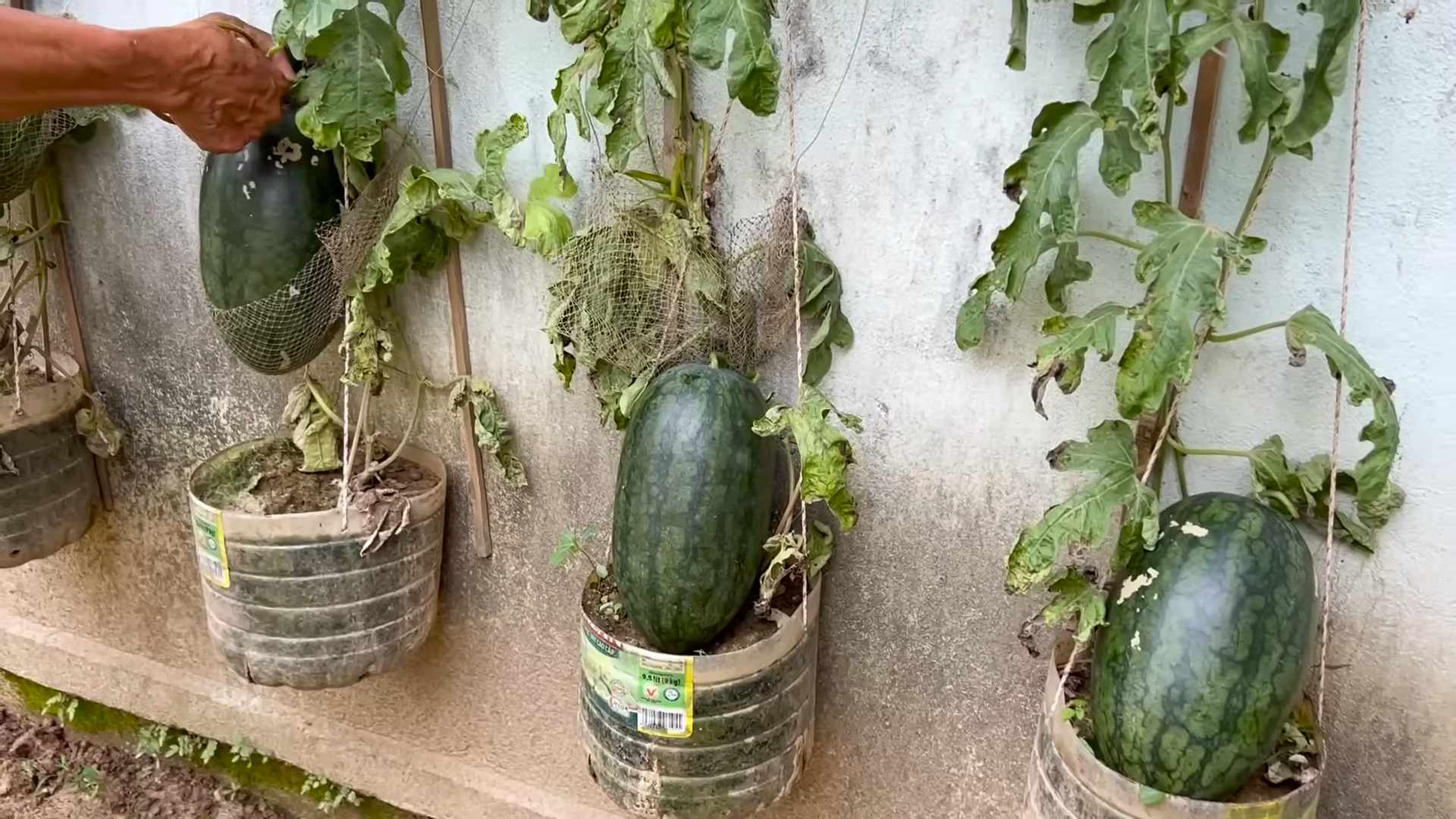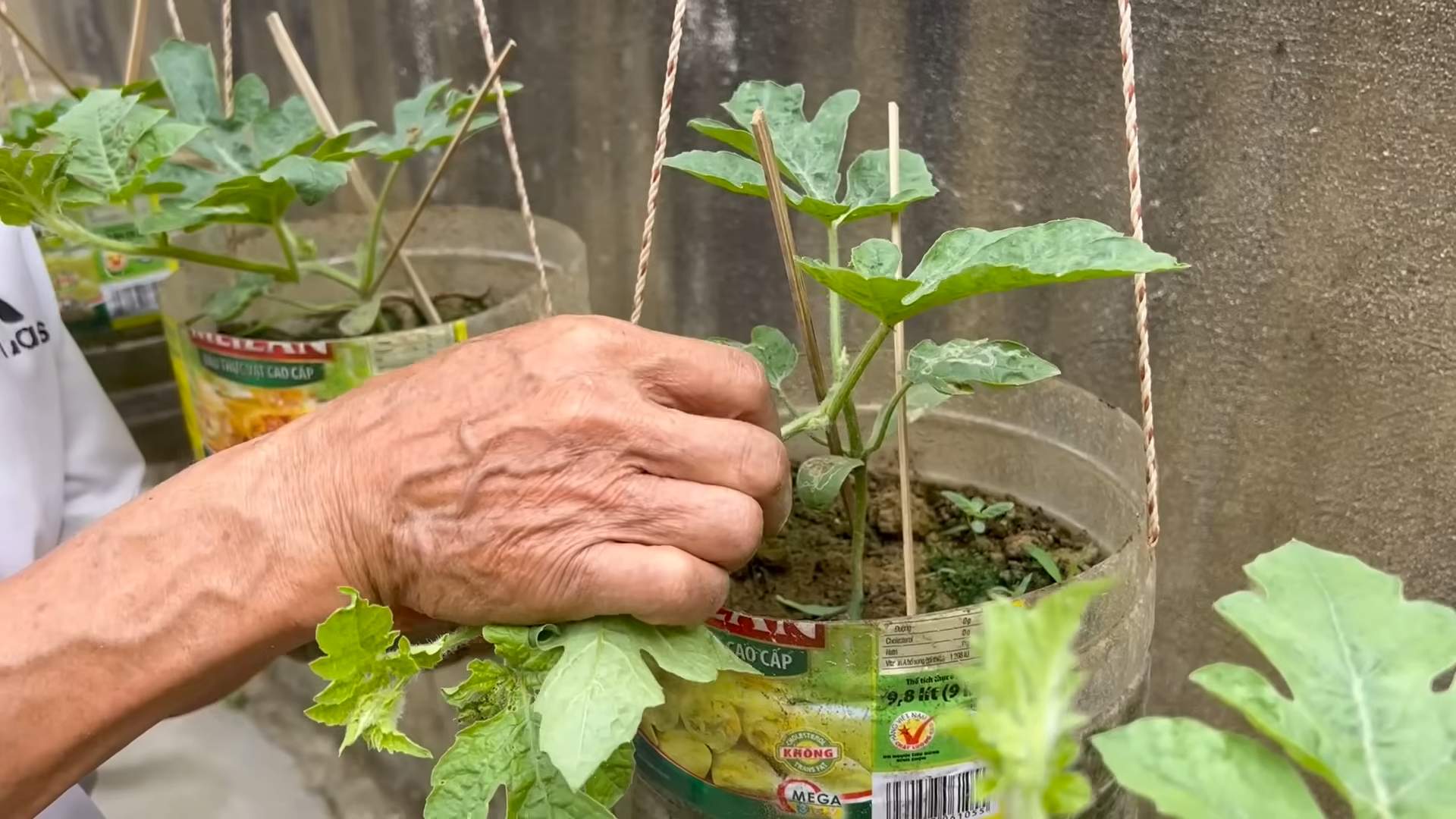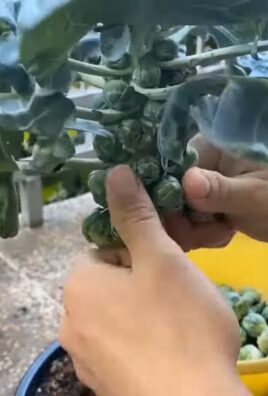Grow Watermelons at Home? Absolutely! Imagine biting into a juicy, sweet watermelon you nurtured from seed to fruit, right in your own backyard. It’s a rewarding experience that’s more achievable than you might think. For centuries, watermelons have been a symbol of summer, abundance, and community, enjoyed in celebrations and family gatherings across cultures. From ancient Egypt, where they were buried with pharaohs, to modern-day picnics, watermelons hold a special place in our hearts (and stomachs!).
But let’s be honest, buying watermelons from the store can be a gamble. Are they truly ripe? Were they grown with care? That’s where the magic of DIY comes in! This article is packed with simple, effective tricks and hacks to help you grow watermelons at home, even if you have limited space or gardening experience. I’m going to share my secrets to successful watermelon cultivation, from choosing the right variety for your climate to warding off pests and diseases.
Why do you need these DIY tricks? Because growing your own watermelons means enjoying fresher, tastier fruit, knowing exactly what went into its cultivation, and experiencing the pure joy of watching something you planted flourish. Plus, it’s a fantastic way to connect with nature and impress your friends and family with your green thumb. So, let’s dive in and discover how you can harvest your own delicious watermelons this season!

Grow Your Own Juicy Watermelons: A DIY Guide
Okay, let’s get real. Who doesn’t love a sweet, refreshing watermelon on a hot summer day? And imagine the bragging rights when you tell everyone you grew it yourself! It might seem intimidating, but trust me, growing watermelons at home is totally doable, even if you don’t have a sprawling farm. I’m going to walk you through everything you need to know, from choosing the right variety to harvesting that perfect, juicy fruit.
Choosing the Right Watermelon Variety
First things first, you need to pick a watermelon variety that suits your climate and garden space. Not all watermelons are created equal! Some are massive, others are compact, and some are better suited for cooler climates.
* Consider your climate: If you live in a region with a short growing season, opt for faster-maturing varieties like ‘Sugar Baby’ (around 75 days) or ‘Bush Sugar Baby’ (even more compact!). If you have a longer, warmer growing season, you can experiment with larger varieties like ‘Charleston Gray’ (around 85 days) or ‘Crimson Sweet’ (around 80 days).
* Think about space: Watermelons are vines, and they need room to spread. If you have a small garden, consider bush or compact varieties. These are bred to take up less space. You can also train watermelon vines to grow vertically on a trellis, which is a great space-saving technique.
* Flavor preferences: Do you prefer a super sweet, red-fleshed watermelon, or something a little different? There are yellow-fleshed varieties, seedless varieties, and even varieties with unique rind patterns. Do some research and find a flavor profile that appeals to you.
* Disease resistance: Some watermelon varieties are more resistant to common diseases like Fusarium wilt and Anthracnose. If you’ve had problems with these diseases in the past, choose a resistant variety.
I personally love ‘Sugar Baby’ because it’s reliable, relatively small, and produces incredibly sweet watermelons. But don’t be afraid to experiment and find your own favorite!
Preparing the Soil and Planting
Watermelons are heavy feeders, meaning they need a lot of nutrients to thrive. So, preparing the soil properly is crucial for success.
* Sunlight is key: Watermelons need at least 6-8 hours of direct sunlight per day. Choose a location in your garden that gets plenty of sun.
* Well-drained soil: Watermelons don’t like soggy feet! Make sure your soil drains well. If you have heavy clay soil, amend it with compost, aged manure, or other organic matter to improve drainage.
* Soil pH: Watermelons prefer a slightly acidic soil pH of 6.0 to 6.8. You can test your soil pH with a soil testing kit and amend it accordingly.
* Rich in organic matter: Watermelons need plenty of nutrients. Amend your soil with compost, aged manure, or other organic matter to provide them with the nutrients they need.
Now, let’s get planting! You have two options: starting seeds indoors or direct sowing.
* Starting seeds indoors: This is a good option if you have a short growing season. Start your seeds about 4-6 weeks before the last expected frost.
1. Fill seed starting trays or small pots with a seed starting mix.
2. Plant 2-3 seeds per cell or pot, about 1 inch deep.
3. Water gently and keep the soil moist but not soggy.
4. Place the trays or pots in a warm, sunny location or under grow lights.
5. Once the seedlings have developed a few true leaves, thin them to one plant per cell or pot.
6. Harden off the seedlings by gradually exposing them to outdoor conditions for a week before transplanting them into the garden.
* Direct sowing: This is a simpler option if you have a longer growing season. Wait until the soil has warmed up to at least 70°F (21°C) before direct sowing.
1. Prepare the soil as described above.
2. Sow seeds about 1 inch deep and 2-3 feet apart.
3. Water gently and keep the soil moist.
4. Once the seedlings emerge, thin them to one plant per hill.
Important Tip: Watermelons are sensitive to transplant shock, so be very careful when transplanting seedlings. Handle them gently and avoid disturbing the roots.
Watering and Fertilizing
Watermelons need consistent watering, especially during hot, dry weather.
* Water deeply and regularly: Water deeply at the base of the plant, avoiding wetting the foliage. Aim for about 1-2 inches of water per week.
* Mulch: Apply a layer of mulch around the plants to help retain moisture, suppress weeds, and regulate soil temperature. Straw, wood chips, or black plastic mulch are all good options.
* Fertilize regularly: Watermelons are heavy feeders, so fertilize them regularly with a balanced fertilizer.
* Before planting: Incorporate a slow-release fertilizer into the soil before planting.
* After planting: Side-dress the plants with a fertilizer high in nitrogen when the vines start to run.
* When the fruits start to set: Switch to a fertilizer high in phosphorus and potassium to promote fruit development.
I like to use a liquid seaweed fertilizer every few weeks to give my watermelons an extra boost. It’s packed with micronutrients and helps them stay healthy and strong.
Pollination
Watermelons need to be pollinated in order to produce fruit. They have separate male and female flowers on the same plant. The male flowers appear first, followed by the female flowers.
* Attract pollinators: Plant flowers that attract bees and other pollinators near your watermelon plants. Some good options include sunflowers, zinnias, and lavender.
* Hand-pollination: If you’re not seeing a lot of bees in your garden, you can hand-pollinate the flowers yourself.
1. Identify the male and female flowers. The female flowers have a small, immature watermelon at the base.
2. Use a small paintbrush or cotton swab to collect pollen from the male flower.
3. Gently transfer the pollen to the stigma of the female flower.
4. Repeat this process for several female flowers.
Important Tip: Pollinate the female flowers early in the morning, when the pollen is most viable.
Pest and Disease Control
Watermelons can be susceptible to a few pests and diseases.
* Common pests: Aphids, squash bugs, cucumber beetles, and vine borers are common watermelon pests.
* Control: Inspect your plants regularly for pests. Handpick them off or use insecticidal soap or neem oil to control them.
* Common diseases: Fusarium wilt, Anthracnose, and powdery mildew are common watermelon diseases.
* Control: Choose disease-resistant varieties. Practice good sanitation by removing diseased leaves and debris. Use a fungicide if necessary.
I’ve found that a strong blast of water from the hose can often dislodge aphids and other small pests. It’s a simple and effective way to keep them under control.
Harvesting Your Watermelons
This is the moment you’ve been waiting for! Knowing when to harvest your watermelons can be tricky, but here are a few signs to look for:
* The tendril closest to the fruit turns brown and dries up. This is a reliable indicator that the watermelon is ripe.
* The bottom of the watermelon (where it rests on the ground) turns from white to yellow or cream.
* The watermelon sounds dull and hollow when you thump it. This takes some practice, but you’ll get the hang of it.
* The rind is hard and difficult to penetrate with your fingernail.
Once you’ve determined that your watermelon is ripe, use a sharp knife to cut it from the vine, leaving a few inches of stem attached.
Important Tip: Don’t wait too long to harvest your watermelons. Overripe watermelons can become mushy and lose their flavor.
Enjoying Your Homegrown Watermelon
Congratulations! You’ve successfully grown your own watermelon. Now it’s time to enjoy the fruits (or should I say, the watermelon) of your labor.
* Chill your watermelon in the refrigerator for a few hours before cutting it. This will make it even more refreshing.
* Cut your watermelon into wedges or cubes and enjoy it as is.
* Use your watermelon to make smoothies, salads, or other delicious recipes.
* Share your watermelon with friends and family and bask in the glory of your gardening success!
Growing watermelons at home is a rewarding experience. It takes some effort, but the taste of a homegrown watermelon is unbeatable.

Conclusion
So, there you have it! Growing watermelons at home might seem daunting at first, but with a little planning, patience, and these simple DIY tricks, you can be harvesting your own juicy, refreshing watermelons before you know it. We’ve covered everything from choosing the right variety for your climate to creating the perfect soil conditions and warding off common pests. But the real magic lies in the hands-on experience, the satisfaction of nurturing a tiny seed into a sprawling vine laden with fruit.
Why is this a must-try? Because store-bought watermelons, while convenient, often lack the intense flavor and sweetness of homegrown varieties. Plus, you have complete control over the growing process, ensuring your watermelons are free from harmful chemicals and pesticides. Imagine biting into a perfectly ripe watermelon, bursting with flavor, knowing you grew it yourself. That’s an experience worth pursuing!
Don’t be afraid to experiment! Try different watermelon varieties to find your favorite. Perhaps you’d like to try growing a smaller, personal-sized watermelon like a Sugar Baby, or maybe you’re feeling adventurous and want to tackle a giant Charleston Gray. You can also experiment with different trellising methods to save space and improve air circulation. Consider companion planting with herbs like basil or marigolds to deter pests naturally. Another variation could be to try growing watermelons in containers if you have limited garden space. Just be sure to choose a large container and provide adequate support for the vines.
Remember, the key to successful grow watermelons at home is consistent care and attention. Keep an eye on your plants, water them regularly, and provide them with the nutrients they need to thrive. Don’t be discouraged if you encounter challenges along the way. Gardening is a learning process, and every season brings new opportunities to improve your skills.
We are confident that with these tips, you’ll be well on your way to enjoying a bountiful harvest of homegrown watermelons. So, grab your seeds, get your hands dirty, and prepare to be amazed by the fruits (or rather, watermelons!) of your labor.
We’d love to hear about your experiences! Share your photos, tips, and stories in the comments below. Let’s create a community of watermelon growers and learn from each other. Happy gardening!
Frequently Asked Questions (FAQ)
Q: What is the best time to start watermelon seeds indoors?
A: The ideal time to start watermelon seeds indoors is about 6-8 weeks before the last expected frost in your area. This gives the seedlings a head start and allows them to establish a strong root system before being transplanted outdoors. Check your local weather forecasts and planting calendars to determine the appropriate timing for your region. Starting them too early can result in leggy, weak seedlings, while starting them too late may shorten your growing season.
Q: How much space do watermelon plants need?
A: Watermelon plants are vigorous growers and require ample space to spread. As a general rule, allow at least 3-4 feet between plants in rows that are 6-8 feet apart. If you’re growing watermelons on a trellis, you can reduce the spacing slightly, but still ensure adequate airflow and sunlight penetration. Consider the mature size of the specific watermelon variety you’re growing, as some varieties can be more compact than others. Insufficient spacing can lead to overcrowding, reduced fruit production, and increased susceptibility to diseases.
Q: What kind of soil is best for growing watermelons?
A: Watermelons thrive in well-drained, sandy loam soil that is rich in organic matter. The soil should have a pH between 6.0 and 6.8. Before planting, amend the soil with compost, aged manure, or other organic materials to improve its fertility and drainage. Avoid heavy clay soils, as they can become waterlogged and inhibit root growth. If you have clay soil, consider growing watermelons in raised beds or containers with a well-draining potting mix.
Q: How often should I water my watermelon plants?
A: Watermelon plants need consistent moisture, especially during fruit development. Water deeply and regularly, providing about 1-2 inches of water per week. Avoid overhead watering, as it can promote fungal diseases. Instead, water at the base of the plants, using a soaker hose or drip irrigation system. Monitor the soil moisture levels regularly and adjust your watering schedule accordingly. During hot, dry weather, you may need to water more frequently.
Q: How do I know when a watermelon is ripe?
A: Determining when a watermelon is ripe can be tricky, but there are several indicators to look for. First, check the tendril closest to the fruit stem. When this tendril turns brown and dries out, it’s a sign that the watermelon is nearing ripeness. Second, examine the underside of the watermelon where it rests on the ground. This spot, known as the ground spot, should turn from white to a creamy yellow color. Finally, thump the watermelon with your knuckles. A ripe watermelon will produce a deep, hollow sound. If it sounds dull or flat, it’s likely not ripe yet.
Q: What are some common pests and diseases that affect watermelon plants?
A: Watermelon plants can be susceptible to various pests and diseases, including aphids, squash bugs, vine borers, powdery mildew, and fusarium wilt. To prevent pest and disease problems, practice good garden hygiene, such as removing plant debris and weeds regularly. Inspect your plants frequently for signs of infestation or disease and take action promptly. Use organic pest control methods, such as insecticidal soap or neem oil, to control aphids and squash bugs. Choose disease-resistant watermelon varieties and provide adequate air circulation to prevent fungal diseases.
Q: Can I grow watermelons in containers?
A: Yes, you can grow watermelons in containers, but you’ll need to choose a large container (at least 20 gallons) and a compact watermelon variety, such as Sugar Baby or Bush Sugar Baby. Use a well-draining potting mix and provide adequate support for the vines. Water container-grown watermelons more frequently than those grown in the ground, as the soil in containers tends to dry out faster. Fertilize regularly with a balanced fertilizer to provide the plants with the nutrients they need to thrive.
Q: How can I improve the sweetness of my watermelons?
A: Several factors can influence the sweetness of watermelons, including variety, sunlight, and watering practices. Choose a watermelon variety known for its sweetness, such as Crimson Sweet or Jubilee. Ensure your watermelon plants receive at least 6-8 hours of direct sunlight per day. Avoid overwatering, especially as the fruits are ripening, as this can dilute the sugars. You can also try adding Epsom salts to the soil, as magnesium sulfate can help improve fruit sweetness.
Q: What should I do if my watermelon plant is not producing fruit?
A: If your watermelon plant is not producing fruit, there could be several reasons. First, ensure that the plant is receiving adequate sunlight, water, and nutrients. Watermelons need plenty of sunshine and consistent moisture to produce fruit. Second, check for signs of pollination problems. Watermelons require pollination to set fruit, so if there are not enough bees or other pollinators in your area, you may need to hand-pollinate the flowers. Finally, make sure the plant is not stressed by pests or diseases. Address any pest or disease problems promptly to help the plant recover and produce fruit.




Leave a Comment